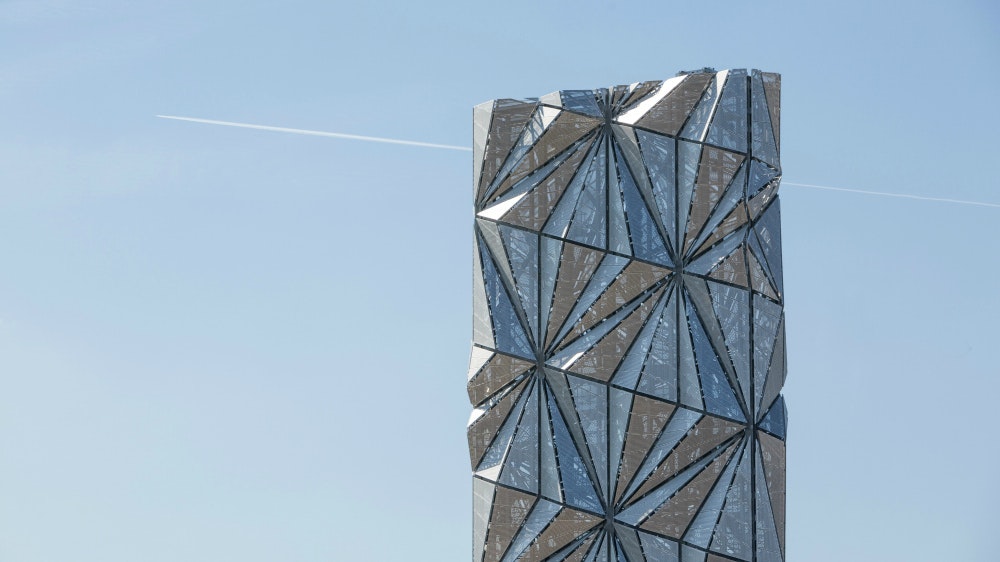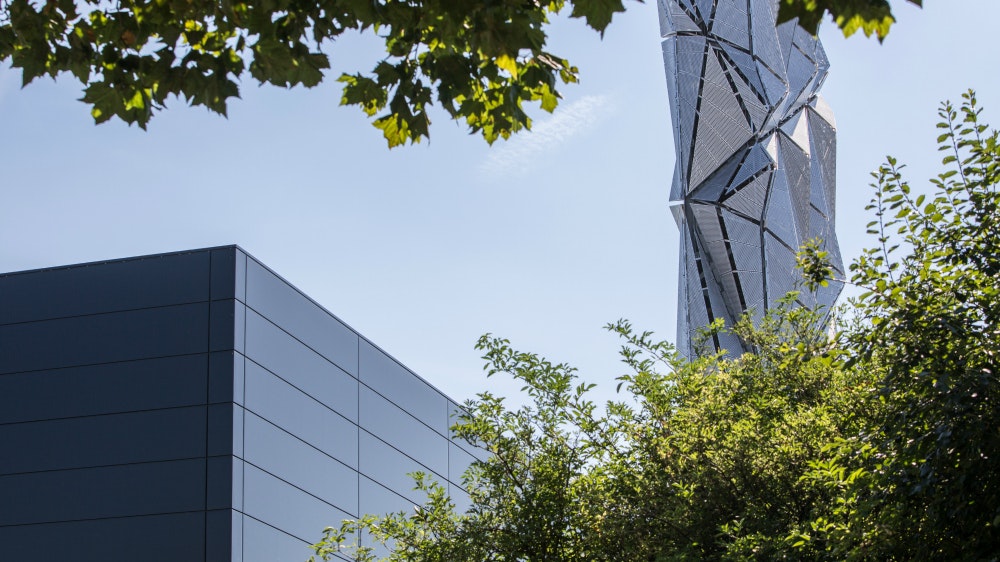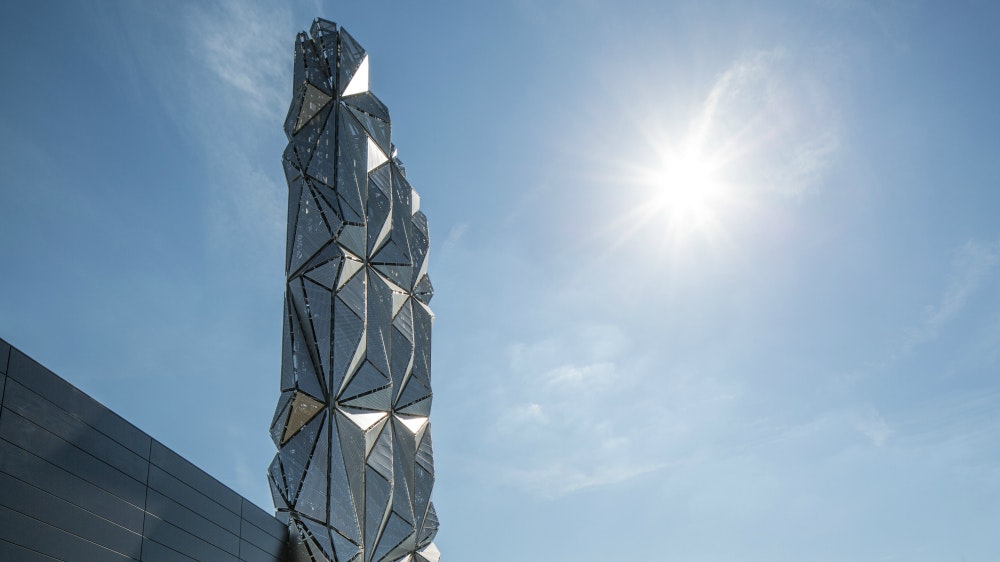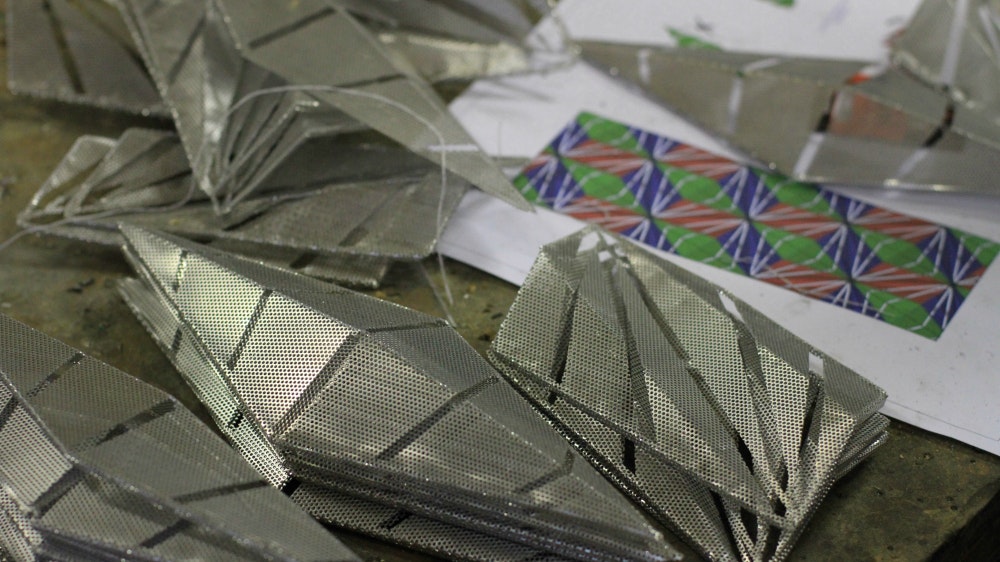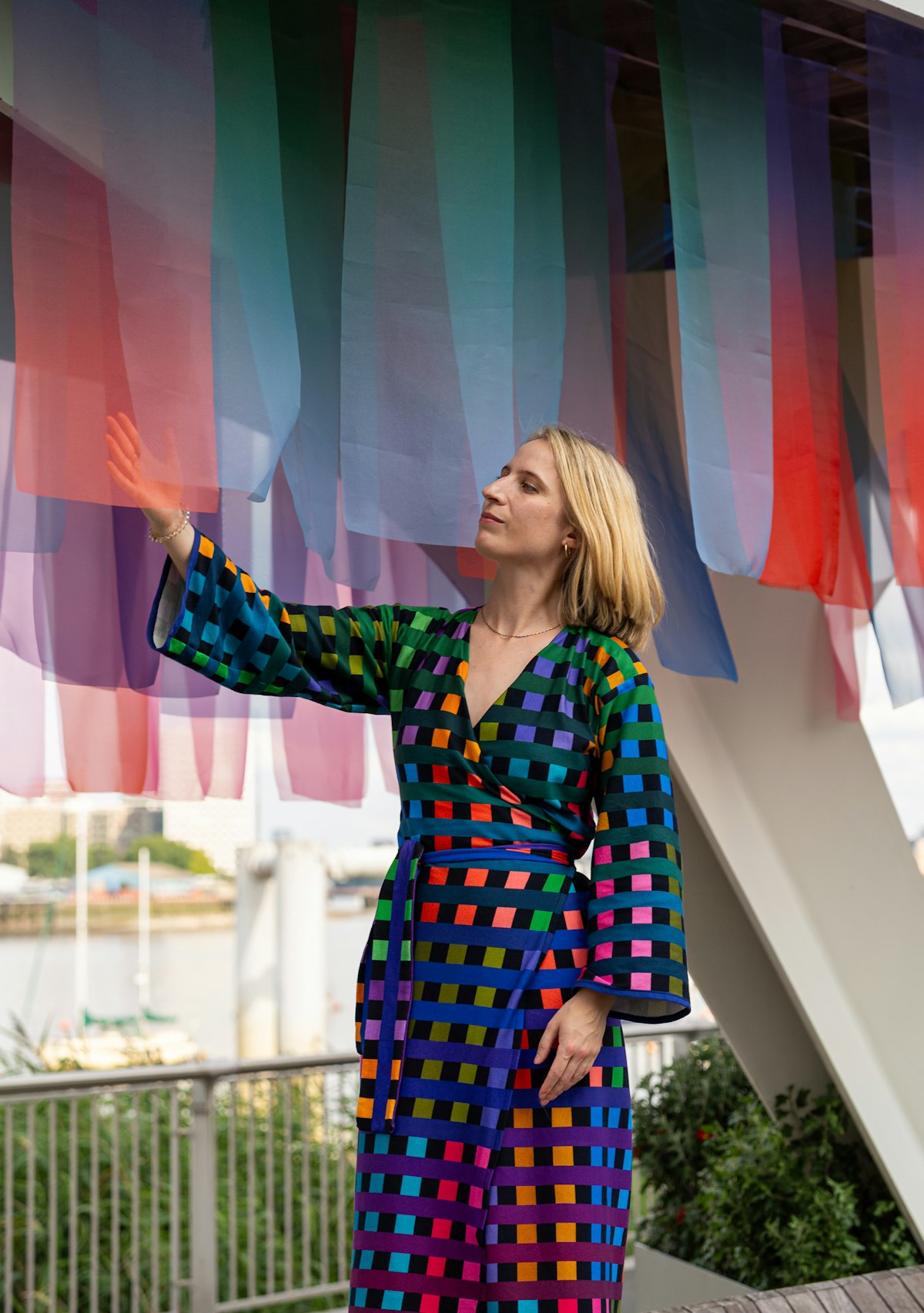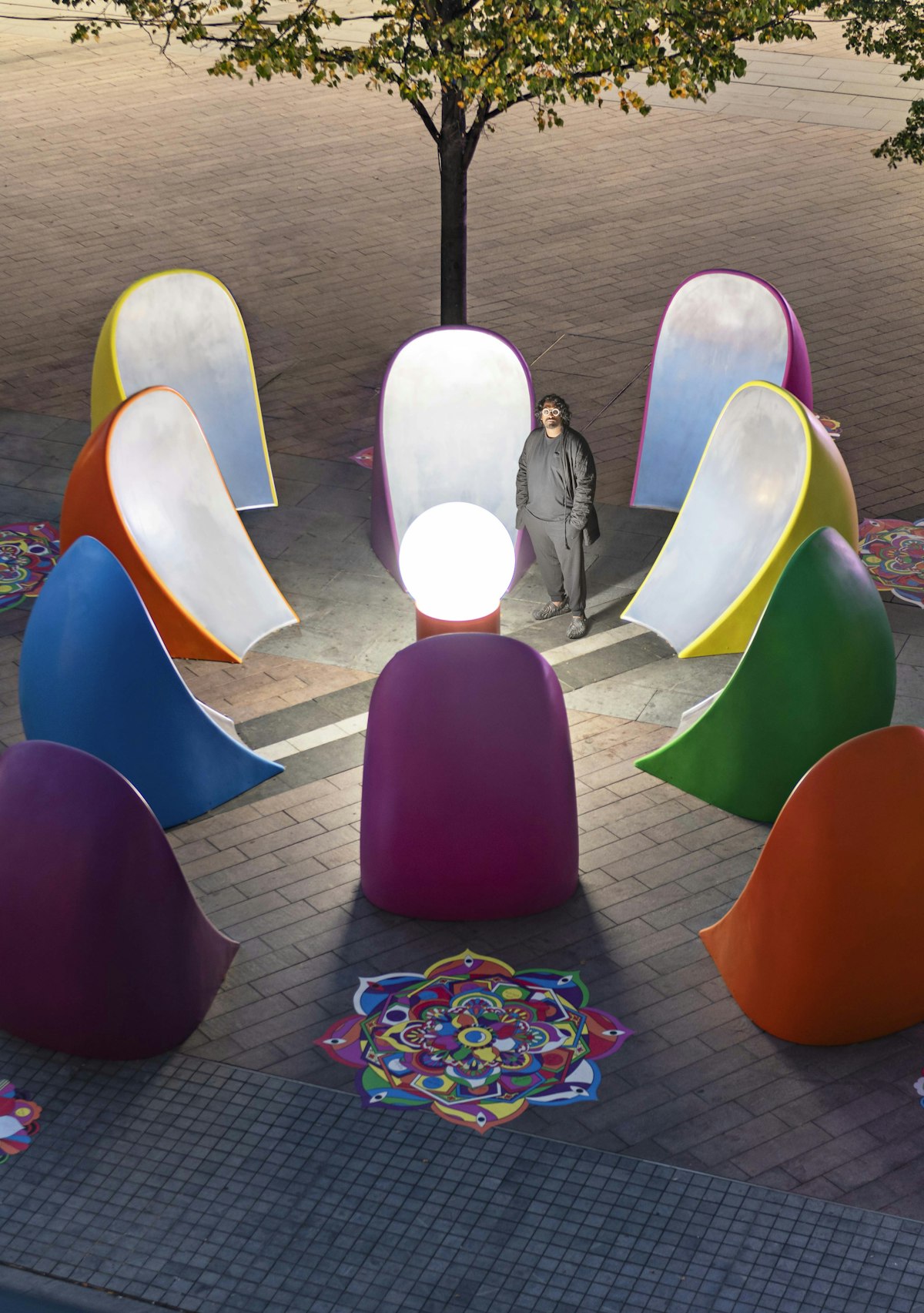
The Optic Cloak and Other Feats Of Magic
Greenwich Peninsula is gathering a remarkable number of permanent pieces of art from an eclectic range of British artists. Work includes Anthony Gormley’s Quantum Cloud, Alex Chinneck’s Bullet From A Shooting Star, Gary Hume’s Liberty Grip, and Richard Wilson’s A Slice of Reality.
Conrad Shawcross’ The Optic Cloak is the latest piece to be embedded into this impressive outdoor gallery, acting as both camouflage to the soon-to-be completed Energy Centre’s soaring flues, and as a beacon to the Peninsula. The Energy Centre will be providing low-carbon energy to more than 15,000 homes on the Peninsula. Central to its design is ‘The Blade’, a series of 50m-tall flues set into a slim, horizontal box. Greenwich council’s request that these should somehow be disguised was identified as an opportunity for a piece of public art. Artists were invited to send in their ideas and Shawcross’ work was selected for its elegance and ingenuity.
Shawcross’ work blends engineering with philosophy, art with architecture, and industrialism with nature. Past pieces have seen him investigating themes like the human nervous system, our perception of time, and the way we engage with machines. By his own admission he is fascinated and inspired by the worlds of science and mathematics as much as art. “As an artist I’m engaged by the way scientific ideas affect our sense of reality, question our sense of self and philosophically position our place in the universe”, he says.
Although often epic in scale and crafted out of materials such as steel and wood, there is an elegant fragility and visual lightness about each piece which alludes to the philosophical concerns that drive him. He is drawn to the plight of innovators and originators; their successes and their failures or “the lonely endeavour” as he calls it.
His own endeavours have seen him build complex rope-making machines with over 150 moving parts, as well as hacking and re-programming industrial-welding robots to dance.
More recently he has completed a commission for the Francis Crick Institute. Monumental and imposing, Paradigm stands 14m high outside the medical research facility in King’s Cross. Unnerving too because it appears to teeter, widening from 1m at its base to 5m at the summit, though it is, of course, quite safely anchored 30m below the ground.
Similarly, when he ‘planted’ the Royal Academy’s Annenberg Courtyard with his piece The Dappled Light of The Sun, a 6m high steel canopy, made from joined-up tetrahedrons, he managed to make its 30 tonnes of steel give the impression of being somehow organic and tree-like. And now, as his latest piece The Optic Cloak is unveiled at the Peninsula’s Energy Centre, he joins the burgeoning collection of artists whose iconic work is not only shaping this nascent part of London but actually drawing people to it. “I was quite interested in the fact that they launched a competition to try and turn this flue into an artwork. There was this idea of, pretending it was not a flue, but a piece of art. There was this sense of disguise, of cloaking something.”
“"The optic cloak itself is brimming with an energy all of its own, a beautiful metaphor for the very thing it’s meant to be cloaking."”
Shawcross and his team began looking at the art and history of camouflage, from natural camouflage like a giraffe’s spots or a parrot’s colourful plumage, to man-made wartime camouflage going back to the early 20th century. He was drawn to the art of ‘dazzle’ camouflage, a technique developed and deployed during World War I that involved painting ships in discordant geometric shapes of varying colours. The idea wasn’t to make the ship invisible, but rather to make it hard to determine its size and which direction it was going in, effectively making it a much harder target to hit.
“We were looking at what makes successful camouflage and one of the paradoxes about it is that on one level it’s very arresting, while on another it disappears. It has this contradictory effect like a parrot in a jungle. It’s very successful at hiding itself and yet it looks like the most obvious thing in the jungle.”
Shawcross was also inspired by the work of fellow Westminster School of Art and Slade School of Art alumnus, David Bomberg (1890-1957). The artist’s pre WWI work combined aspects of cubism and futurism which sought to both express and hide the human form under brightly coloured, repetitive geometric patterns.
“I was looking at Bomberg and how to create these grids and disrupt a surface. Then came my initial idea of creating folded panels over the surface; a panel system that would go over the surface of the building, make it disappear yet more arresting.”
Realising that the tower was uniquely placed on the Peninsula, Shawcross then looked to fully take advantage of the fact the sun essentially rises facing one side of it and sets facing the other.
“The sun will face one side of it in the morning and the other in the evening, so I was looking at this idea that the back and the front could be opened up [by the sun], making it transparent. I was looking at things like the moiré effect.”
Moiré is the resulting pattern seen when two geometrically regular patterns (as two sets of parallel lines or, as in The Optic Cloak’s case, two panels covered in holes) are superimposed especially at an acute angle. The effect is of a shimmering nature, reminiscent of intense heat seen distorting the air in a desert or rising off an asphalt road.
The brilliance of The Optic Cloak is that though it can be seen from a great distance (from the clippers travelling up and down the river or from the top of Greenwich Park) the closer you get to it the lighter and more elegant it looks. Shawcross’s engineering and experimentation have come together to create a striking work of art. “When the light is on the same side as you when you come round, it starts to shimmer and gets this optic, disruptive surface, hence the name The Optic Cloak” he says. But Shawcross is modest, because it does so much more than that.
At dawn it gradually reveals itself, throwing off the shadows of night to reflect and refract the sun slicing across the pleated panels. At sunset, the structure shimmies and glows, almost alight with the last licks of daylight.
It’s as if The Optic Cloak itself is brimming with an energy all its own, a beautiful metaphor for the very thing it’s meant to be cloaking.
